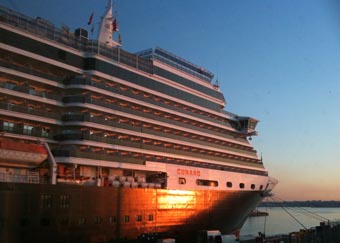Travelling by ocean liner – a green alternative…?
12 Jan 2010written 9th Jan
For the last few days I’ve been enjoying the luxuries of the Cunard White Star Line ocean liner “Queen Victoria“, as it makes its way across the North Atlantic from Southampton England to New York. We’re currently just entering the shipping lanes of the East coast of America, above the island of Nantucket, and I’m watching the container ships gather on the horizon from the luxury “Commodore Lounge” at the top of the ship. I say luxury because I’ve sadly found that these cruise liners aren’t really built for travelling across oceans: they’re built for “cruising”. By and large, my fellow guests are retired, well-off and in couples; whereas I am a single young man: one of only two that I have met on board. Most guests seemed to have “cruised” before – one retired English couple blaisely spoke to me about their 10th world cruise. Clearly I have very different motivations from almost everyone on board: my motivation has been Slow Travel and minimising the damaging greenhouse gas emissions that flying to New York would have caused. My young friend – a philosophy lecturer in his late 30s – shares my motivation about slow travel, but his main motivation is fear of flying. Unfortunately, because of the social scene these cruises don’t seem to lend themselves to be enjoyed by youngsters (under 50). And, perhaps because the motivation for most guests is not to ease pressure on our shared global environment, the effect is not particularly environmentally friendly either.
Personally I could do without the grand “Royal Court Theatre” that occupies the forward parts of decks one to three. And as much as I’ve personally welcomed the small onboard gym I could probably manage with just the one swimming pool (not three). But with a casino, a ballroom, a disco, four restaurants and many more cafes and bars, the Queen Victoria sets itself up to be a high “consumer” of energy and resources.
In fact, before booking the journey I was pained to find that ocean liners typically use 120 kWh of energy for every “100 passenger kilometres”. That’s in fact more than an Boing 747 airliner, at – depending on fullness – between 30 and 53 kwH per 100 passenger kilometres [according to David MacKay’s very useful “Sustainable Energy Without the Hot Air” (p.128)]).
By Cunard’s own calculations the ship emits about 0.53070307 kg of CO2 per passenger mile. Multiplied by what I estimate as a rough distance for the trip of 3422 miles, that is a total of 1816.1 kg of CO2. That is alot of CO2, whichever way you look at it; more than most people in the world are responsible for in a year.
By contrast according to the calculator at Choose Climate the same distance by plane would create only 650kg of CO2. So, what on earth am I, as a green, doing taking a form of transport that emits more CO2 than a plane…?? The answer is two-fold: the first is that the plane’s CO2 emissions are not the whole story. We know these days that due to the total warming effect of CO2 plus H2O (contrails) plus Nitrous Dioxide in the upper atmosphere, the damage from an aeroplane at 40 000 feet is effectively tripled, so that the original 209 kg of fuel which burns with twice the amount of oxygen to create 650 kg CO2… creates 1949 kg of CO2-equivalent warming effect, delivered direct to the upper atmosphere, where it does instant damage.
So already, with this amendment, even the ship’s vast CO2 emissions per passenger just narrowly beat the plane’s.
Secondly, however, I wanted to travel by sea for a different reason: I was simply damned if I was going to fly.
Apart from anything else, if there is no viable alternative to taking the plane, where is the consumer choice in that, and what does that say about our society’s one-track version of progress? It seemed obvious to me that surface travel by ship should be less environmentally-damaging than air travel, and when I was unable to find a suitable passenger-carrying container-ship, I turned to ocean liners as the next most environmentally-friendly way to get across the Atlantic (needless to say, if I had been able to find a container ship on which to travel then the environmental impact of my presence on board it would have been truly negligible, as MacKay’s book discusses).
Aside from the aesthetic slow travel aspect (which has been wonderful), the high figure of the ship emitting 1816.1kg of CO2 on my behalf on the journey also accounts for my being put up in 4 star hotel luxury for seven days with a la carte meals three times a day (it’s a battle to get out of the restaurant at any point during the day and do something to work off the calories), entertainment, shops, and a support team of 1000 staff (one for every two guests).
Herein lies part of the hope I feel for ocean travel as a (more) sustainable alternative than plane travel. Plane staff could barely be pared back. But (labour considerations aside) downscaling a ship’s staff complement/guest experience by a third would reduce the experience to a mere 3 star luxury, which would be quite enough for me. Because the Queen Victoria with all its luxury already manages a lower overall level of climate-damage than an aeroplane, just think what could be achieved by trading in some of the luxury and adding some more environmentally-inclined processes to the ship’s layout and systems. A ship that was truly designed for moving people across oceans rather than being a floating hotel for well-off retireees could I’m sure give the aeroplane a run for its money in terms of environmental credentials. With the right investment and market conditions, a new era of ocean-going travel could provide a viable and more-environmentally-friendly alternative to transatlantic flights.
And lower prices might allow a greater diversity of people to enjoy the experience of slower, more environmentally friendly travel.
 Email This Post
Email This Post
12 Jan 2010 Matt Wootton



Dear Matt,
I was very intrigued by your choice. Did you also consider the embodied energy in the construction of a cruise ship, compared to a boeing?
e.g. in a 2 week period, a cruise ship can take say 500 passengers over the atlantic, and bring 500 back.
A boeing can take 500 passengers across the Atlantic in a few hours, refuel, and take 500 more passengers back the other way. So schedule 1 flight a day each way, and it can transport 14,000 passengers in the same 2 week time period.
Maybe my figures aren’t quite right, but I reckon you’d therefore need to construct at least a couple dozen cruise ships for each boeing you want to replace.
What would that do to the relative carbon footprints of flying vs cruising?
Best of luck in America (whatever you’re doing there!!!)
Hi Peter,
you make some very valid points.
To dispense with the numbers, it’s more like 3000 people on the cruise ship, taking 6 days.
But I think if crossing the Atlantic took 6 days rather than 6 hours, it would automatically stop lots of the business flying that corporate globalisation is so fond of, and force corporations towards tele-conferencing and (god forbid) maybe even localisation, or not endlessly monopolising in the first place.
Of course I didn’t look at embodied energy, and I’ve not seen figures for it, but I suspect the answer is either that the boat is still better, or that we can’t afford to do either. I don’t see that anyone could possibly make an argument that continuing to indefinitely use planes is environmentally better. Cheers.
Hi Matthew, and Hallo Peter.
Doing these embodied energy calculations is complicated, and (as you know, Matthew, from my recent dissertation!) you can come up with some unexpected findings. However, the Oasis of the Seas (the largest cruise liner) apparently weighs the same as 100,000 middle size cars. We can guess a weight of, say, 1mt (1000 kgs) per car. A Boeing 747 weighs 600,000 pounds unladen (266,667 kgs). This makes the liner 375 times the weight of the plane. The 747 carries 416 – 524 passengers (depending on configuration) and the liner carries in excess of 6000. (so, a ratio of about 12). So, the mass per passenger ratio is still about 31. If you make the (terribly rash and incredibly simplistic) assumption that the liner is largely steel, and the plane is largely aluminium, and assume that ‘virgin’ material is used, then with an EE of 31.5 MJ/kg for sheet steel, and 214 MJ/kg for Al extrusions, the EE ratio (liner:plane) is about 4.6. But of course, we shouldn’t be looking at virgin materials. The world-wide recycle rates for Al and steel are currently about 33% and 43%, but it has been reported that as much as 90% of the UK Al for large constructions is from recycling. In addition, there may be uncertainties about the EE for Al, as much of this is due to the energy used in the electrolytic reduction process, and much of this energy is from renewable sources (hydroelectric). And all of this ignores the life-time of the ‘product’ (which should probably be calculated in passenger miles), and how much maintenance (and thus further embodied energy) is required during this life-time.
And ignores the thousands of other components of these ‘vessels,’ made of numerous materials in numerous more or less complicated (and thus energy-consuming) ways.
Which all goes to show that any simple ‘assumption’ is highly likely to be way off the true position.
But looking at the energy in construction PLUS energy in use (PLUS energy in disposal), is certainly the right concept. And given the highly different purposes of a cruise liner and a plane, a comparison such as I have carried out above is completely misleading anyway!
I can’t help but agree, however, that if all the effort that has gone into the development of planes had instead gone in boats and trains, we would by now have much more ‘sustainable’ means of transport. But would it have satisfied the desires of the holidaying masses (amongst which I include myself)? Taking several days to get to and from Benidorm doesn’t seem to most people as appealing for a week’s holiday. So surely it’s not the means of transport that needs changing first, but aspirations. And that is going to be a massive task.